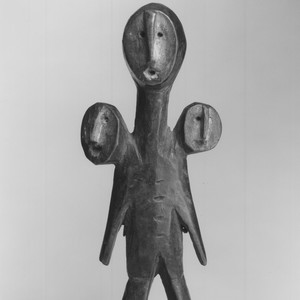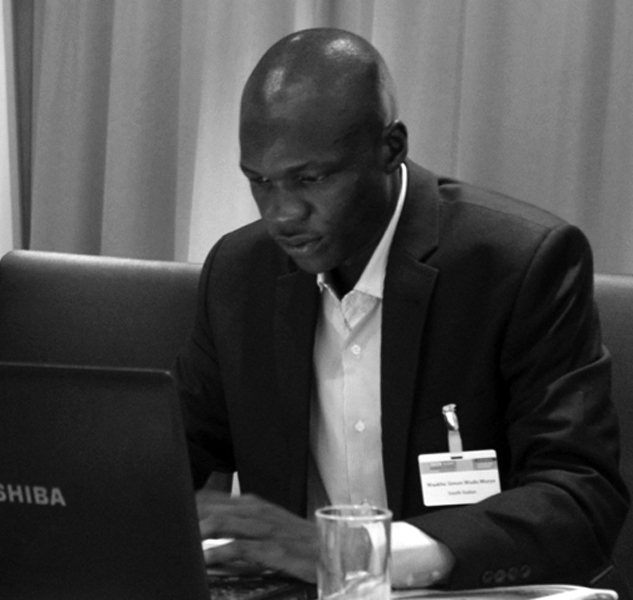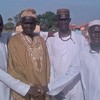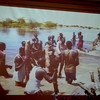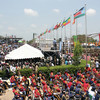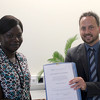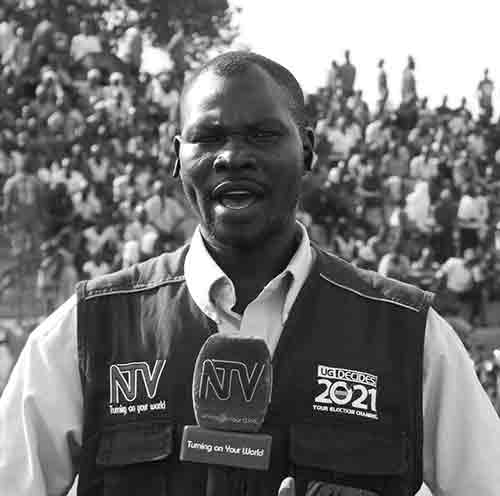Unresolved border dispute haunts local communities
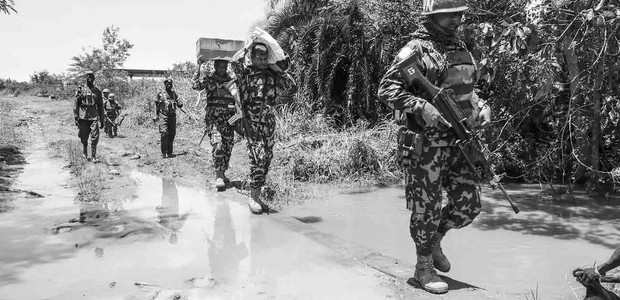
Juan Vicki Robina from Kajo-Keji in South Sudan and Dipio Kevin Gift from Moyo in Uganda are just two of many victims of the long-running border conflict that has shattered lives, families and communities.
For decades, the Kuku and Mà’dí people lived side by side, sharing socio-economic and cultural ties, bound by intermarriage and learning each other’s language and culture. The stories of Robina and Kevin, aged 37 and 26 years, respectively, highlight years of psychological, physical and economic troubles caused by the two border points.
The boundary between Kajo-Keji and Moyo has been a ‘soft’ border, hardly enforced or contested during the pre-Comprehensive Peace Agreement (CPA) Sudanese civil wars. However, following the CPA and South Sudan’s independence, the lack of definition of the border has been a driver of conflict, with particular contention for the area around Sunyu, a fertile crop growing area.
Historic differences of opinion are now leading to tension between South Sudanese Kuku and the Ugandan Mà’dí border communities. This tension has escalated with violent clashes in Kajo-Keji and Moyo. In 2014, one of the deadliest and most bloody conflicts broke out between the two communities. According to local officials, at least 20 people were killed, and 200 huts were torched.
Some Mà’dí youth went from house to house searching for Kuku residents. They beat anyone they found, setting their homes ablaze and looting their shops and other businesses. Hundreds of Kukus, many of whom had lived in Moyo for decades, were sent scampering for their lives.
I don’t have
any courage
to go to
South Sudan.
Within the blink of an eye, the border town of Jale on the Kajo-Keji side of the border streamed with hundreds of horror-stricken people of all ages and from all walks of life. Pupils and students slipped away from their schools, running through bushy paths for fear of being clubbed by schoolmates and villagers.
At the time of the violence, Robina’s big family had settled in Moyo for years after escaping the 1983 Southern Sudan-Sudan conflict. All was well before 2014. Kuku people freely engaged in trading and were treated like citizens of Moyo. The area had become Robina’s second home, and her parents and siblings felt they were there to stay. The conflict, however, turned their lives upside down.
Reprisals against the Mà’dí people left at least 2,500 residents in Moyo temporarily forced to flee to Adjumani, a neighbouring district. Few Mà’dí people residing in Kajo-Keji at the time had to run for their lives. Some of them were rescued by local authorities in Kajo-Keji and survived beatings. But many others were unlucky and lost both property and lives.
Dipio Kevin Gift, a mother of one, resides in the Lowi Quarter residential area in Moyo town, located around 15 kilometres from Kajo-Keji. It takes about 30 minutes by motorbike to cross from Moyo to Kajo-Keji. Dipio lost her brother on the side of Kajo-Keji during the revenge attacks turned on the Mà’dí people. Many Mà’dí youths, including Dipio’s brother, had crossed the border to South Sudan to work in local construction in Kajo-Keji.
Anger, trauma, pains
Around a decade later, locals live with unresolved trauma and anger. Efforts to talk and pursue justice remain elusive – preventing the two sides from resuming the former ties of friendship and economic opportunities.
To locals like Dipio, living on the Ugandan side, the opportunities and relations she used to enjoy have faded. “I don’t have any courage to go to South Sudan and never dream of going,” she told The Niles. “The trauma of my brother tortured me a lot.”
Others also have lingering trauma. Robina, a mother of three, told The Niles how her house in Moyo was set ablaze with all her possessions inside. She was forced to relocate her 62-year-old mother and some of her family members because of the imminent danger they were facing.
It will take
some time
before I
forget.
“My brother was cut with a panga. He was chopped on the head, then the forehead and then his hands were also chopped, and because he did not get help on time, he bled to death. He was not even taken to hospital,” said Robina.
When things turned violent in Moyo, some Kuku people back in Kajo-Keji started revenge on some of the Mà’dí people residing in Kajo-Keji.
According to eyewitnesses, locals on both sides used machetes, bows and arrows and sticks, among other weapons. The damages inflicted were on both sides.
Robina said that she and her mother could not move on after the violence. “To tell you the truth, I haven’t forgotten up to today,” she said. “It will take some time before I forget. It can skip off my mind, but if it comes back to me, I feel so hurt.”
Started decades ago
The conflict in 2014 was caused by the shared border. The boundary dispute is not simply a failure of governments to define and demarcate this stretch of the international border but needs to be understood in the context of changing land values, patterns of decentralisation and local hybrid systems of land governance.
Henry Kala Sabuni, the former commissioner of Kajo-Keji County, who now heads the Central Equatoria State Commission for Conflict Resolution and Reconciliation, explained to The Niles that it started when authorities in Moyo decided to go and conduct a census in Sunyu, a small village in Kajo-Keji where Kuku people live.
“The Ugandan government was trying to make some enumeration for their census for Uganda,” he said, adding that the local district council had some resolutions which extended the count to a part of Kajo-Keji, a village of Sera Jale Boma that was included in the map of Uganda.
“When Moyo district authorities sent their enumerators to register people from that village, the population of the Kuku community that belongs to the Republic of South Sudan often refused to be enrolled or registered as Ugandans. This brought about a problem between Moyo and Kajo-Keji,” Kala explained.
Meanwhile, authorities in Kajo-Keji detained the officials from Moyo for illegal encroachment into South Sudan, Kala said. They were eventually released and, upon return to Moyo, the leadership of the Moyo District, led by the then Moyo District Chairperson Vukoni Jimmy Okudi, together with other politicians, mobilised some local youth who then started violently protesting the detention in Kajo-Keji.
These districts
have been divided
mainly on an
ethnic basis.
Ever since the 2014 violence, the once free border crossings and contact between the Kuku and Mà’dí have not yet returned to normalcy, he said.
According to Kala, the conflict in 2014 was not the first of its kind fought by the two communities over land and border issues. At the tender age of 12, Kala claims he learnt from his grandfather, Sabuni, that in the 1940s seven people were killed in a conflict.
However, it did not escalate because the person accused of having caused the murder of the seven people on the other side of the community was found guilty by a court and was executed as punishment.
Border conflicts also led to South Sudan’s President Salva Kiir Mayardit and Uganda’s President Yoweri Museveni meeting in the area in 2009 to try and resolve disputes between Kajo-Keji and Moyo. The governments formed a border committee to work out plans to demarcate unclear border points, but no tangible success has been registered over ten years later.
Growing populations, as well as political influence at the state leadership level, are critical drivers of the continuing border conflicts. In recent years, the respective country’s leadership has strengthened local governance in Uganda and South Sudan. Institutions of new local government systems have been accompanied by sub-division of administrative units.
Many people in South Sudan and northern Uganda — like others around the world — see boundaries and borders as a potential source of clarity, security and conflict prevention, said a research report entitled “Dividing Communities in South Sudan and Northern Uganda”, authored by Cherry Leonardi and Martina Santschi of the Rift Valley Institute. It said political and economic ambitions, and fears of discrimination or exclusion from land, promote more rigid boundaries, both at local levels and between groups of people.
For instance, in South Sudan, the report said in 1994, the Sudan People’s Liberation Movement [South Sudan’s ruling party] had formally committed itself to decentralisation. In 2004, the party held a conference of traditional leaders. It produced the Kamuto Declaration, which affirmed respect for “cultures” and the “responsibilities of Traditional Leaders and Chiefs, particularly regarding the tenure and ownership of land and other resources belonging to their respective communities”.
In Uganda, on the other hand, the number of districts increased from 34 in 1990 to 112 in 2013, said the Rift Valley report. “While a variety of explanations have been given as to the extreme nature of district creation in Uganda, perhaps the most plausible is that new districts have been a source of electoral patronage for President Yoweri Museveni,” the report said.
“These districts have been divided mainly on an ethnic basis, and their creation has reduced what were once ethnically heterogeneous districts to ones largely populated by only one or two major ethnic groups”, it said, adding that they often sparked conflict in the process, enhancing the sense of divisions between different groups.
Other border conflicts
Along the South Sudanese-Ugandan border, there has recently been a rise in conflicts between neighbouring communities in both countries. According to media reports, similar border conflicts continue to recur along a border point between Magwi County (South Sudan) and Lamwo District (Uganda). Radio Tamazuj had reported that in August 2015, Magwi County officials said 150 families left their homes in fear after Ugandan forces entered Pogee during a land dispute.
In December 2015, South Sudan and Uganda signed a memorandum of understanding to ease the border tension and allow the demarcation of the disputed approximately 470-kilometres-long boundary. Still, little progress has been made since then. In May 2018, South Sudanese soldiers halted road construction in Uganda’s northern district of Lamwo.
Meanwhile, South Sudan and Kenya are battling for a contested piece of land on their border. The oil-rich Elemi Triangle has been claimed by the two countries pitting a threat to diplomatic ties between the two countries. In recent years, the disputed area has seen clashes among local communities of the three countries which all border each other at that point: South Sudan, Kenya and Ethiopia. No permanent solution has been reached, and tensions continue.
Ice breakers
In the absence of a lasting solution to the problem from the states, interventions by some peace actors can help temporarily break the cycle of recurring conflicts.
The Nile Basin Initiative (NBI) is a regional governing body trying to forge cooperation among countries sharing the River Nile, including South Sudan and Uganda. The initiative attempts to halt some of the rising conflicts between communities sharing borders.
The Nyimur Multipurpose Water Resources Project, for example, is implemented through the Nile Equatorial Lakes Subsidiary Action Program (NELSAP), one of two investment programmes under the NBI that benefits residents in South Sudan’s Magwi County and residents in Northern, Eastern and Northeastern Uganda, is among the initiatives that non-state actors can emulate to deescalate clashes.
It will sustainably
improve both
countries’ socio-
economic
development.
The initiative aims to increase the locals’ resilience in the targeted communities by changing socio-economic and natural conditions, including climate variability and climate change, which subsequently increases agriculture production in the long run. It also aims to stabilise border movements between the two countries and manage combined and joint land and water resources management.
The Nyimur project is a beacon of development in the beneficiary communities that accelerates the “development of remote areas and motivates cooperation between the involved countries,” Mwasiti Ally Rashid, the NELSAP Programme Officer for Water Resources Management and Development, told The Niles.
“Apart from increasing cooperation between the two countries and security in the project areas, it will sustainably improve both countries’ socio-economic development through water resources development and management for increased availability for multi usages including flood and drought mitigation, irrigation, electricity generation, fisheries development, and water supply,” Rashid added.
Calls for intervention
Meanwhile, in the Moyo and Kajo-Keji communities, the process of recovery from the violent clashes is slow, and anxiety remains high among many people from both groups.
“I just pray that it doesn’t happen again,” said Robina, emphasising the need for the two countries’ leadership to address the problem genuinely.
I just pray
that it doesn’t
happen again.
“The leaders might be far away, and their lives may never have been affected by this, but for us, they have to look for the way forward,” Dipio said, urging the two governments to start discussions to ensure peace in the region.
According to the two countries’ policies, the demarcation of the borders is the task of the respective national leadership. All efforts being made by local authorities, including dialogue and peace conferences, are at best temporary initiatives.
Anyama Williams, a senior Moyo District local government official, explained to The Niles that the solution to finally address the problem lies in a final decision and efforts by Juba and Kampala.
“The two governments are never committed to very clearly demarcating the border. They seem to be solving the problem by avoiding responsibility and pushing the burden to the next generation,” Williams said. “The sovereignty and the territorial integrity of these two countries need to be defined. Let the borderline be known by everybody so that we have our respect restored.”
